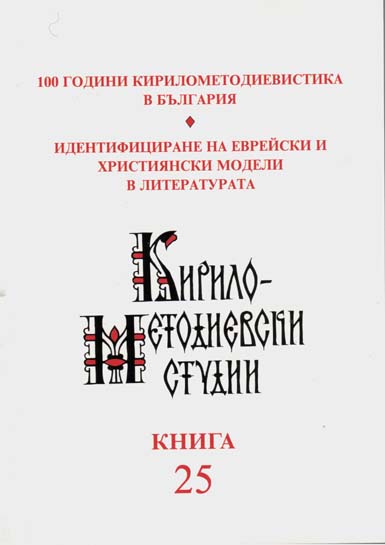Среднодунавски славяни в българските земи през Ранното средновековие
Slavs from the Middle Danube Region the Bulgarian Lands During the Early Middle Ages
Author(s): Kamen StanevSubject(s): 6th to 12th Centuries
Published by: Кирило-Методиевски научен център при Българска академия на науките
Keywords: Slavs in the Middle Danube Region; Early Middle Age
Summary/Abstract: The problem about the settlement of Slavs in the Middle Danube region in the lands, which during the early Middle Ages became part of the Bulgarian state has not been subject of a particular study. It is due mainly to the scarce information by the written sources. Besides the information is quite limited, it allows assuming that the Slavs’ settling in the Balkan Peninsula lasted long after their mass population at the beginning of 7th c., while at the same time there was also a dislocation of already settled groups. A significant part of the Slavs came from the Middle Danube region and subsequently they became part of the Bulgarian state and joined the Bulgarians, which were formed as an ethnicity group in a contemporary sense at that period. This is evidenced by some archaeological data, as well as a number of toponyms that have exact parallels in the nowadays lands of the Czech Republic and Slovakia. These data indicate a presence of Slavs with Middle Danube region’s origin, without being able to say exactly when, and under what circumstances this resettlement happened. There is information by the written sources about three migrations at the 9th – the beginning of the 10th centuries which migrations were caused by various reasons, had a different character as a number and a composition of the migrant groups and finally they had different meanings for the Bulgarian history. The first migration happened in 835, when a small group of aristocrats headed by Pribina, the Prince of Nitra and his son Kotzel found a temporary protection as refugees. It was a typical political emigration, which according to the available written data had no impact on the Bulgarian history. The second migration is well known. It was caused by the struggle for supremacy between the Methodius’ students and the German clergymen in Moravia after Methodius death in 885. In this struggle the German clergy were supported by the Great Moravia Prince and as a result of that the older students were expelled, and the young were sold in slavery. According to the written sources, those sold into slavery were about 200 people and can hardly be any doubt that most of them had originated from the Great Moravian Slavs. They were brought to Venice, where a Roman bought them and sent them to Constantinople, and there they were allowed to go wherever they wish and a large number of them came to Bulgaria, where at the same time came the expelled older students from whom we know Clement, Naum and Angelarius. Thus the carefully educated by Methodius Slavic spiritual elite of Great Moravia, they finally settled in Bulgaria and together with Clement and Angelarius (Byzantine Slavs) formed the first generation of writers using Slavic language here. It is very probable that the Bulgarian writer Konstantin of Preslav had also a Moravian origin, which is known to have been a student of Methodius, i.e. he joined Methodius after the death of Constantine-Cyril (869). This means that he became a student when Methodius acted by himself in the Principalities of Lower Pannonia and Great Moravia (870–885) and there is no data for Slavic from Byzantium and Bulgaria to join him as students. This migration, although small in general, had a great importance for the Bulgarian history. As a result of it the Slavic language was established as the language of the Bulgarian church and administration, which in turn accelerated the imposition of the Slavic language as common of the forming during this period Bulgarian nationality. The third migration had occurred at the end of 9th – the beginning of 10th century and it was a consequence of the Great Moravia’s defeat by the Hungarians. Information about it is to be found in two independent from each other sources – a Bulgarian and a Byzantine. Unfortunately, the sources did not say how the participants were and where they settled. The significance of this migration is shown by its mentioning in two sources different in origin. Given the traditional Bulgarian policy during this period to settle non-Bulgarian groups close to the borders, can be assumed that some of the Great Moravia refugees were settled in southern Macedonia, which territories were conquered shortly before this event.
Journal: Кирило-Методиевски студии
- Issue Year: 2016
- Issue No: 25
- Page Range: 320-335
- Page Count: 16
- Language: Bulgarian
- Content File-PDF

